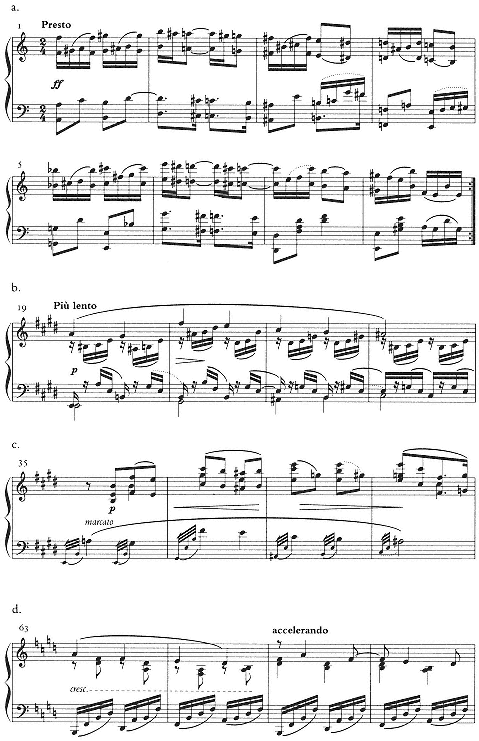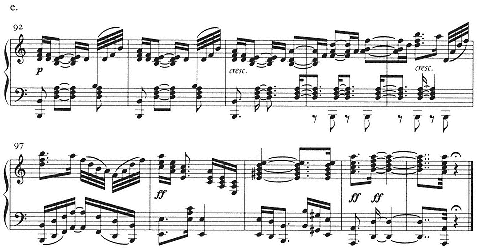The Three Piano Pieces and Scherzo of 1894
As I have suggested elsewhere, a symphony theme cited by Schoenberg as having been written by him in about 1892 already shows a familiarity with Brahms's Tragic Overture specifically, and with Brahms's procedures of thematic evolution more generally (Frisch 1984, 159). Schoenberg's Three Piano Pieces of 1894 (printed complete in SW A4: 73–83), the first substantial instrumental compositions that survive, show that the twenty-year-old composer had continued to study Brahms intensively—in this case, the short piano works published recently in Brahms's collections opp. 116, 117, 118, and 119 (1892–93).
What is striking in the first of Schoenberg's 1894 pieces, an Andantino in





eighth note "early" on the notated downbeat of m. 10. Although notated and perceived downbeats coincide here, the


The last two sixteenth notes of m. 10 hover uneasily in a kind of metrical void: they sound neither like the last beat of a





Schoenberg's complex metrical procedures derive directly from Brahms, who often shifts the entire framework by a beat so that notated and perceived meters are out of phrase for long stretches.[3] But in his almost single-minded concentration on the metrical dimension of the music, Schoenberg tends to leave the others underdeveloped. The harmonic language of the Andantino remains very conventional, as does the basic phrase structure. Despite the metrical blip in mm. 9–11, the whole first section of the piece, up to the double bar, comprises four phrases in

In Schoenberg's Andantino, mm. 1–3 constitute the first statement, beginning and closing on the tonic; mm. 4–6 are the "complementary repetition," beginning on the tonic and moving to III;[4] mm. 7–12, comprising twice as many measures as each of the preceding parts, are the developmental continuation and
[4] In Schoenberg's formulation (1967, 21–24) the second phrase is called the "dominant form," normally beginning on V (his locus classicus is the opening of Beethoven's Piano Sonata in F Minor, op. 2, no. 1). He also acknowledges other possible harmonic schemas, including beginning the second phrase on the tonic and concluding it in a contrasting key.

Example 2.1
Schoenberg, Piano Piece in

conclusion (ending on VI). Schoenberg observes in Fundamentals of Musical Composition that the "development" in the last portion of a sentence usually consists of reducing the thematic material to its smallest components, a process he calls "liquidation" (1967, 58). Liquidation is lacking in the piano piece, however: the basic three-measure unit (in notated measures) remains essentially intact and is given two full presentations in mm. 7–12.[5] What is "developed" is clearly the metrical aspect: the "early" arrival in m. 10 and the mysterious "extra" beat at the end of the same measure constitute the most dramatic changes in the basic unit.
Like many of Brahms's short pieces, and like Reger's Resignation, the Andantino has a ternary form; in this instance the middle section (mm. 13–26) serves as a kind of development of the opening material. As in mm. 7–12, the development is primarily metrical in nature. Indeed, it is the same





Schoenberg varies the return of the opening section in m. 27 (ex. 2. 1): the main theme now appears in canon between the two hands, decorated with an inner part moving in triplets. The canon here serves not purely as a contrapuntal variation of the material, but as further metrical manipulation, which now obscures both the notated and perceived frameworks.
Schoenberg's Andantino, then, can be said to adopt certain outward "symp-
toms" of Brahms's style, evident in the arpeggiated bass and in the piano texture in general, and one more specific technical aspect, that of metrical development. But the piece may be said to founder precisely because the areas of motivic development, harmony, and phrase structure are not treated at the same level as, and are not adequately coordinated with, the metrical procedures (as happens, for example, in the first movement of Brahms's

In these respects the third of the piano pieces, a Presto in A minor, is more ambitious and, it might be said, more successful. In his brief memoir of Schoenberg's youth, David Josef Bach makes the intriguing remark that "with its remarkable rhythm" this piece "already contains the seed of the later Schoenberg" (Bach 1924, 318). Unfortunately, Bach specifies neither what aspect of its rhythm is remarkable nor what prefigures the later Schoenberg. But he is right to imply that the piece is the most advanced of the three.
The progressiveness is not apparent in the phrase structure, which, as in the Andantino, is in itself quite square. The opening eight measures (ex. 2.2a) form what Schoenberg calls a "period" (Schoenberg 1967, 25–31), comprising a fourmeasure phrase and its varied restatement, or what we can call an antecedent and a consequent. (A period generally has two phrases of equal length, unlike a sentence.) In the Presto, both antecedent and consequent end on the dominant; the antecedent begins on the tonic, the consequent on a diminished seventh. The progressive aspect consists of the way this traditional design is filled out with chromatic harmony, specifically with what Schoenberg would later call "vagrant" chords (Schoenberg 1978, 134, 257–67); these are harmonies, such as diminished or half-diminished ones, that are ambiguous and can be led in different directions. Although the tonic is clearly implied by the bass in the first half of m. 1, it is nevertheless obscured by the right-hand arpeggiation of the diminished triad,


Brahms is an obvious source for this kind of controlled, intense chromaticism, as, for example, in the Capriccio, op. 116, no. 3, where the tonic G minor is continually subverted until the end of the A section.[6] The Brahmsian pedigree of the Presto is even more evident in Schoenberg's striving to make the entire tex-
[6] Thieme 1979, 81–82, has pointed to the importance of Brahms's Capriccio, op. 76, no. 1, as a model for the texture and figuration of the middle section of Schoenberg's Presto.

Example 2.2
Schoenberg, Piano Piece in A Minor (1894).

Example 2.2
continued
ture "thematic." The alto inner voice of the B section is derived from the main theme of the A section (ex. 2.2b). Later, the B theme moves into the bass and is presented simultaneously in diminution in the right hand (ex. 2.2c).[7]
The middle section lies in the key of the dominant; but Schoenberg avoids any strong cadential V-i motion at the return to the A. Instead, the return is made via the half-diminished ii7 chord, a vagrant harmony that is sustained for ten measures (mm. 63–72) by means of the energetic working of a descending motive A-F-E-D (ex. 2.2d).[8] The coda (mm. 92–101; ex. 2.2e) is built from the same harmony and motive; the motive is now compressed or diminuted even further and is subject to rhythmic displacement similar to that used in the Andantino in


[7] For the first procedure, see, for example, the first movement of Brahms's Second Symphony, where the arpeggio of the first theme forms (in diminution) the accompanying inner part to the second theme (as mentioned in the previous chapter). For the second, see Brahms's song Mein wundes Herz, op. 59, no. 7, where both voice and accompaniment are derived from the same material.
acts as the transformational beat, and the notated meter returns on the first beat of m. 97. The final cadence to the tonic in mm. 100–101 is made not via the dominant, but from a final appearance of the half-diminished (now in first inversion).
The intensity with which the ii7 chord is manipulated, both motivically and harmonically, suggests something of the later early Schoenberg: in the next chapter we shall see him exploiting the same sonority throughout the song Mädchenfrühling (1897). Yet because the phrase structure tends to remain four-square (even the B section unfolds in rigid four-measure units) and because the melodic invention is less than inspired, our final impression is one of a rather static, undevelopmental form.
A more fluid and sophisticated approach to phrase structure is evident in an eighty-measure fragment in

The first contrasting theme begins with this measure of tonic (not with the preceding dominant) and, like the main theme, consists of two parallel groups of eight measures. The first (mm. 18–25) moves from the tonic to its relative major, A, the second (mm. 25–32) back to the dominant. But these groups overlap, so that the final measure of the first (m. 25) is also the initial measure of the second. The ambiguity is heightened by the initial measure of each phrase (18 and 25), which remains in a sense athematic: the principal motive appears only in the second measure (19 and 26). The result is that m. 18 tends to sound like an introduction and m. 25 like a transition, even though these measures form an integral part of the overall phrase structure.
Thus, although they add up to an even number on the largest scale, the first thirty-two measures of the scherzo do not divide squarely into 8+4, as tends to
[9] See Maegaard 1972, 1: 149. The piece, edited by Reinhold Brinkmann, is published in SW B4:101–4.
happen in the Three Pieces of 1894. Rather, the "extra" measure, m. 17, and the compensating overlapping measure, m. 25, make the internal division asymmetrical:
MAIN THEME
Unit 1: mm. 1–8
Unit 2: mm. 9–16
"Extra" measure: m. 17
FIRST CONTRASTING THEME
Unit 1: mm. 18–25
(Overlapping measure: m. 25)
Unit 2: mm. 25–32[10]
Within the contrasting theme, the motivic working seems more fluid than in the other pieces of 1894. In the first phrase (mm. 18–21), as we have seen, the basic motive appears in the second measure (accompanied by figuration derived from m. 2 of the main theme) and then is rhythmically augmented and transformed across the third and fourth (20–21). In the second phrase the motive appears in the first two measures (22–23), but is absent from the cadential motion of the second two (24–25). The two phrases are thus not simply parallel, as is often the case in the piano pieces of 1894.